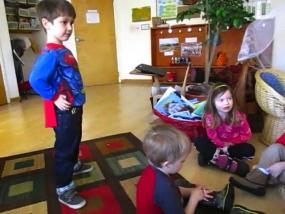Sharing Weekend Adventures

In this video clip, the children’s relaxed, patient and confident participation in sharing time shows that this is a well-established classroom routine. The clear structure of this social event helps the children understand the roles of the participants and join in with success. The sense of routine offers the children reassurance that they will have a turn to talk and facilitates their active engagement in the present. By providing opportunities and encouragement to relate personal narratives, we help young children give order to past experiences, strengthen oral communication skills, and begin learning how to tell stories. Nolan adopts conventions that define the role of the speaker. He “holds the floor” by standing up to talk, signals that he has finished sharing by inviting questions from the audience, and maintains his leadership role by selecting which peers have an opportunity to ask questions. Nolan enjoys being the speaker, but also transitions easily to the role of audience member. Showing that he understands the turn-taking structure of this communicative event, Nolan yields the floor in order to give another child a turn to talk. The children also demonstrate a strong understanding of the role of an audience member. They show each other respect by listening attentively, raising their hands to ask a question, waiting patiently to be selected by their peer, and again listening attentively as each question is asked and answered. The children have different presentation styles. Nolan reflects on and shares a sequence of activities, pauses to recall (“and then, I, I, I was at my home…”), and skillfully creates a sense of finale by gesturing with his body as if climbing on the rings at the fitness center. Brady enthusiastically shares one significant event from his weekend (“I went to the pool”), and with the teacher’s encouragement (“What else?), also talks about another weekend adventure (skiing). The children are learning about the reciprocal relationship between the speaker and the audience as they participate in sharing time. The child decides what to talk about, but also receives feedback about which experiences and amount of detail capture the interest of his audience. The teacher works in several ways to support the children’s participation. She lets the children know that their experiences outside of school are valued by explicitly inviting them to share something they did over the weekend. She offers positive encouragement (i.e., “great question”). At times, she facilitates transitions by providing closure (“Thank you Nolan for sharing that. That was great.”), and by posing invitations (“Brady, would you like to share about something you did this weekend?”). At other times, the teacher holds back and gives the child an opportunity to independently negotiate the next part of the social interaction. For example, Nolan (not the teacher) asks, “Does anybody have any questions?” She also lets the children know that their questions are of equal importance to what the speaker has shared by allowing time for several children to ask follow-up questions. As the children gain competence sharing noteworthy events in a social setting, they also learn about what makes for a good follow-up question. With hands raised, the children wait to ask questions, but once called upon, do not seem to have a real question in mind. Perhaps they don't commit in their minds to a question until they are called upon. The children ask both general and specific questions. When formulating specific questions, the children make a connection with their peer by reflecting on their own life experiences. For example, Simmy asks Brady, “Um, um, um, did you had a break and have something to eat?” and then explains, “Because my sister had - my sister went skiing with my cousin but I did not, and she had a break and ate something.” The children also understand they can remain an active participant and support the social interaction by asking a more general question (“Did you have lots, and lots, and lots of fun?”). Well-defined events such as sharing time help young children develop strategies that form the backbone of social interactions throughout life. Length of video: 3 minutes 20 seconds Keywords: Fours, Children-Teacher, Communication, Language, Listening, Classroom Routines, Teaching
